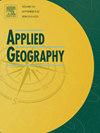Vegetation restoration contributes to a reduction in wind and water erosion in China's drylands
IF 4
2区 地球科学
Q1 GEOGRAPHY
引用次数: 0
Abstract
Climate change and intensified human activity have increased soil erosion in China's drylands. Understanding the levels and trends of wind and water erosion in China's drylands over the past decades and analysing the contribution rate and spatiotemporal variations of vegetation cover and meteorological factors in wind and water erosion risks is crucial for land management. We applied the RWEQ and RUSLE models to assess the inter-annual trends, simulate the spatial patterns, and identify the factors contributing to wind and water erosion in China's drylands. Our findings revealed that (1) Water and wind erosion exhibit distinct spatial patterns across China's drylands. The southeast regions, with higher precipitation, predominantly experience water erosion, while the northwest regions, with higher wind speeds and lower rainfall, are more susceptible to wind erosion. (2) Meteorological factors significantly influence soil wind and water erosion, and this influence is increasing. However, the buffering effect of vegetation cover is shown to mitigate the erosive impact of these meteorological conditions in this study. By analysing the contributions and trends of soil erosion factors, this study provides valuable insights for developing targeted land management strategies and implementing practical eco-restoration efforts to achieve land degradation neutrality.
求助全文
约1分钟内获得全文
求助全文
来源期刊

Applied Geography
GEOGRAPHY-
CiteScore
8.00
自引率
2.00%
发文量
134
期刊介绍:
Applied Geography is a journal devoted to the publication of research which utilizes geographic approaches (human, physical, nature-society and GIScience) to resolve human problems that have a spatial dimension. These problems may be related to the assessment, management and allocation of the world physical and/or human resources. The underlying rationale of the journal is that only through a clear understanding of the relevant societal, physical, and coupled natural-humans systems can we resolve such problems. Papers are invited on any theme involving the application of geographical theory and methodology in the resolution of human problems.
 求助内容:
求助内容: 应助结果提醒方式:
应助结果提醒方式:


